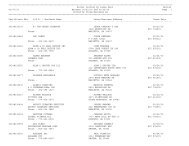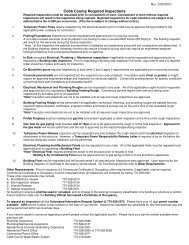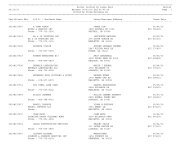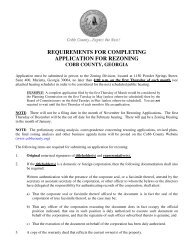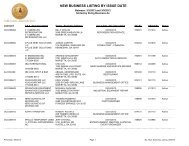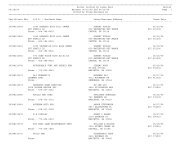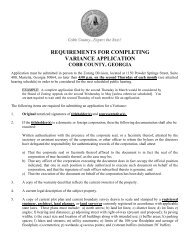State Route 6 Corridor Study Final Report - Cobb County Government
State Route 6 Corridor Study Final Report - Cobb County Government
State Route 6 Corridor Study Final Report - Cobb County Government
Create successful ePaper yourself
Turn your PDF publications into a flip-book with our unique Google optimized e-Paper software.
area thrive. Single‐family homes, townhomes, condos, and apartments should all be<br />
allowed to develop here. They should be co‐located and not separated into clusters.<br />
This will enable life‐cycle housing, which means persons of all income brackets and age<br />
can live in the same community and in close proximity to each other. More housing<br />
choices could aid in building a stronger commercial employment and tax base, as more<br />
choices allows a greater variety of people to live and work in the area. Housing product<br />
diversification is primarily needed at the high‐end of the spectrum within different<br />
segments of the corridor. Additionally, quality rental product is sorely needed in<br />
different segments of the corridor as well.<br />
There is some strip center development along SR 6 that is ripe for redevelopment. It is<br />
important to make room for new businesses, just as it is important to make room for<br />
new residents. Retail pruning is going to be critically important along the corridor in<br />
the future. This basically means that having abundant low‐quality space is actually<br />
worse than having less space but of higher quality. Secondary and tertiary retail uses<br />
can overwhelm the marketplace and discourage the interest of developers and potential<br />
merchants. A critical component in redevelopment in relation to retail is to ensure that<br />
existing retail is successful and sustainable. It is better to have fewer tenants or lower<br />
total square footage and have it be quality and the kind consumers want, than filling up<br />
existing shopping centers with discount, low‐quality, or under‐performing retailers.<br />
Moving towards more nodal development along the corridor will be important for the<br />
future. In lieu of linear, spread‐out development stretching out along and facing SR 6,<br />
concentrating development at key nodes would be better for long‐term development<br />
viability and sustained investment. Nodal development enables the maximum<br />
leveraging of investment, whether infrastructure, residential, retail, office, or industrial.<br />
It can also serve to greatly enhance the opportunities for transit and pedestrian<br />
movement in the corridor. Further, it allows more focused and concentrated efforts by<br />
both the public and private sectors to implement successful development over the long‐<br />
term.<br />
2.3 Transportation Trends<br />
The continued growth and development will result in travel demand increases<br />
throughout the corridor. The ARC travel demand model was used to evaluate just how<br />
much growth would occur, given the anticipated growth patterns. The model indicates<br />
that total number of trips occurring daily in the corridor was approximately 616,500<br />
trips in 2005. Between 2005 and 2030, it is forecasted that trips will increase by 47<br />
percent to nearly 907,000 trips. As a portion of work trips, total daily work trips in 2005<br />
<strong>Final</strong> <strong>Report</strong> 2‐4<br />
January 2008



